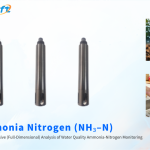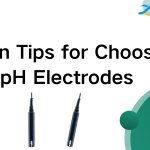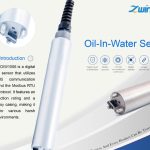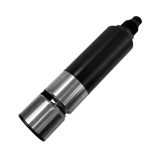(1)Digital Residual Chlorine Sensor ZWIN-LCL1006

Product introduction:
The digital residual chlorine sensor is an instrument used to measure the concentration of residual gas in water samples. Residual chlorine refers to the remaining chlorine in the water, including free chlorine and combined chlorine. It is the chlorine used to kill bacteria and other micro organisms during the disinfection process. Usually based on electrochemi-cal or optical principles. Electrochemical sensors determine residual gas concentration by measuring the current produced by the reaction between gas and electrodes. Optical sensors determine chlorine concentration by measuring its absorption or scattering of light of specific wavelengths.
Performance parameters:
⭐Measurement principle: three-electrode system constant voltage method;
⭐Measuring range: 0~20mg/L;
⭐Accuracy: ±2%FS;
⭐Resolution: 0.01mg/L;
⭐Repeat rate: <0.1mg/L;
⭐Drift: <0.1mg/L;
⭐Temperature compensator error: <0.1mg/L;
⭐Response time: <15s;
⭐Working temperature: 0-50℃;
⭐Sensor size (DxL): Φ34×225;
⭐Shell material: POM;
⭐Protection level: IP68,6bar;
(2)Digital Nitrate Nitrogen Sensor ZWIN-NON1006

Product introduction:
A digital nitrate nitrogen sensor is an instrument used for real-time monitoring of nitrate nitrogen (NO3-N) and nitritenitrogen (NO2-N) concentrations in water, and determines the concentration of nitrate nitrogen in water through ion electrode measurement.
Performance parameters:
⭐Measurement principle: three-elec-trode system constant voltage method;
⭐Measuring range: 0~20mg/L;
⭐Accuracy: ±2%FS;
⭐Resolution: 0.01mg/L;
⭐Repeat rate: <0.1mg/L;
⭐Drift: <0.1mg/L;
⭐Temperature compensator error: <0.1mg/L;
⭐Responsetime: <15s;
⭐Working temperature: 0-50℃;
⭐Sensor size (DxL): Φ34X225;
⭐Shell material: POM;
⭐Protection level: IP68,6bar.
(3)Digital Redox Potential Sensor ZWIN-ORP1006

Product introduction:
The digital redox potential sensor is an instrument used to measure the redox potentia lin aqueous solution, a param-eter that reflects the relative strength of the oxidant and the reductant in the solution. It usually consists of a working electrode (such as a platinum or gold electrode) and a reference electrode (such as a silver/silver chloride electrode). The working electrode is in contact with the solution, and the potential difference of the redox reaction occurring on the electrode is measured.
Performance parameters:
⭐Measurement principle: platinum electrode;
⭐Measuring range:-2000~2000mv;
⭐Accuracy: <5%;
⭐Resolution: 0.1mv;
⭐Repetition rate: <1mv;
⭐Drift: <0.3mv;
⭐Temperature compensator error: <1mv;
⭐Response time: 15s;
⭐Working temperature: 0-60℃
⭐Sensor size (DxL): Φ34X225;
⭐Housing material: POM;
⭐Protection level: IP68, 6bar.
(4)Digital Oil In Water Sensor ZWIN-OlW1006

Product introduction:
The digital oil in water sensor is a device that uses the natural fluorescence properties of oil to detect oil-water mixtures in real time. It can detect various types of oil. It uses the fluorescence properties of oil under ultraviolet light. When ultraviolet light is irradiated on the oil, the oil wil fluoresce. The light detector of the oil-water sensor measures the intensity of this fluores-cence, which is proportional to the amount of oil in the water.
Application areas:
lt has a wide range of applications and can accurately detect pollution during the day or night, on land or in water, and can be detected at any temperature. In industrial applications, these sensors are used to monitor leaks during oil and gas extraction, monitor industrial medical water treatment, monitor oil emissions from ships, and conduct environmental monitoring.
Performance parameters:
⭐Measurement principle: UV fluorescence method;
⭐Measuring range: 0~50ppm;
⭐Accuracy: <5%;
⭐Resolution: 0.001;
⭐Repetition rate: <3%;
⭐Response time: < 15s;
⭐Working temperature: 0-50℃;
⭐Sensor size (DxL): ф34X225;
⭐Housing material: titanium alloy;
⭐Protection level: IP68, 6bar.
(5)Digital chlorophyll Sensor ZWIN-CHL1006

Product introduction:
The working principle of this sensor is to use the characteristics of chlorophyll in the spectrum. By emitting light of a specific wavelength to illuminate the water body, chlorophyll will release fluorescence of another wavelength after absorbing the energy of the light. Then the intensity of this fluorescence is measured by using relevant detection technology. The fluorescence intensity is proportional to the content of chlorophyl in the water body, so the concentration of chlorophyll can be indirectly determined. lt has a self-cleaning function to remove attachments in water samples, maintenance-free, no sample processing and extraction, non-destructive, reagent-free, pollution-free, accurate measurement, low detection limit, and good long-term stability. Long-life LED light source, built-in optical attenuation compensation, longer sensor life. Plug and play, no calibration required for first use.
Application areas:
aquaculture, environmental monitoring, drinking water source monitoring, sewage treatment.
Performance parameters:
⭐Measurement principle:fluorescence method;
⭐Measuring range: 0~500ug/L;
⭐Accuracy: <5%;
⭐Resolution: 0.01ug/L;
⭐Repetition rate: <5%;
⭐Response time: < 15s;
⭐Working temperature: 0-50℃;
⭐Sensor size (DxL): ф34X225;
⭐Housing material: titanium alloy;
⭐Protection level: IP68, 6bar;
(6)Digital Blue-Green Algae Sensor ZWIN-BGA1006

Product introduction:
The working principle of this sensor is usually based on the fluorescence method. When a certain wavelength of excitation light is used to illuminate the water body, the pigment in the blue-green algae will be excited to a high energy state. When it returns to the ground state from the high energy state, it will emit fluorescence greater than the excitation wavelength, and the excited fluorescence intensity is related to the concentration of blue-green algae. By detecting this fluorescence intensity, the content of blue-green algae in the water body can be indirectly determined. It has a self-cleaning function to remove attachments in water samples, maintenance-free measurement, low detection limit, good long-term stability, ultra-bright LED light source, improve sicnal-to-noise ratio, enhance stability, plug and play, and no calbration is reguired for the first use.
Application areas:
aquaculture, environmental monitoring, drinking water source monitoring.
Performance parameters:
⭐Measurement principle: optical method;
⭐Measuring range: 0~2000kcells/mL;
⭐Accuracy: <5%;
⭐Resolution: 0.1Kcells;
⭐Repetition rate: <5%;
⭐Response time:< 15s;
⭐Working temperature:0-50℃;
⭐Response time: <15s;
⭐Working temperature: 0-50℃;
⭐Sensor size (DxL): Φ34×225;
⭐Housing material: titanium alloy;
⭐Protection level: IP68,6bar;
 Tianjin Zwinsoft Technology Co., Ltd
Tianjin Zwinsoft Technology Co., Ltd





您好!من فضلك قم بتسجيل الدخول